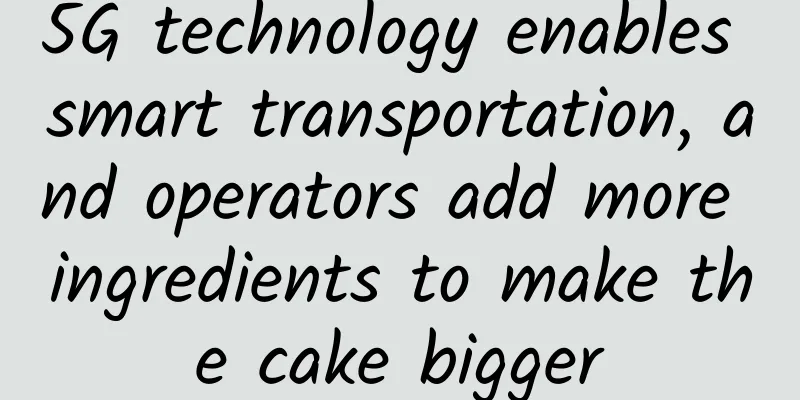5G technology enables smart transportation, and operators add more ingredients to make the cake bigger

|
Recently, the Ministry of Transport, together with the National Standards Committee, the Railway Bureau, the Civil Aviation Administration, and the Postal Administration, jointly issued the "14th Five-Year Plan for the Development of Transportation Standardization" (hereinafter referred to as the "Plan"). The "Plan" clearly states that by 2025, a high-quality standard system for transportation will be basically established, the standardization operation mechanism will be more sound, the internationalization level of standards will be significantly improved, and the role of standardization in supporting the acceleration of building a strong transportation country and building a national comprehensive three-dimensional transportation network will be more prominent. Transportation is the main artery of national economic development, and smart transportation plays a key role in promoting my country's modernization process. After the "14th Five-Year Plan" was issued, operators have actively responded and leveraged the advantages of 5G technology to empower the smart transportation industry.
Planning for smart transportation in the 14th Five-Year PlanLiu Zhenkui, deputy director of the Science and Technology Department of the Ministry of Transport, said in an interview that the "Plan" is positioned as a comprehensive transportation special plan, covering five major areas: railways, highways, waterways, civil aviation and postal services, and covering five levels of national, industry, local, group and enterprise standards, including five aspects such as policy and system, technical standards, internationalization, implementation supervision, and support and guarantee, to guide the standardization work of the entire industry during the "14th Five-Year Plan" period. The "Plan" mainly includes four parts: current situation and situation, overall thinking, key tasks, and guarantee measures. There are seven key tasks. In the field of smart transportation, the Plan proposes to promote the construction of new infrastructure, the application of new generation information and communication technology, and the construction of a smart transportation innovation system, accelerate the formulation and revision of key technologies and common basic standards in smart transportation technology, data resource integration, and Beidou navigation system applications, and improve the level of transportation informatization. The policy has been issued to clarify the general direction and future goals of the transportation industry. The next step is to see how it is implemented. Operators empower smart transportation constructionThe era of the Internet of Everything has arrived. Telecom operators have joined hands with all walks of life based on their own advantages. Through in-depth cooperation in the fields of Internet of Vehicles, 5G communications, smart transportation, etc., they are actively promoting the integration and innovation of the automotive industry and the communications field. China TelecomIn Anhui, China Telecom and Beijing Digital Government Company have carried out all-round and diversified cooperation around the information construction in the fields of digital housing and construction, smart urban management, and smart transportation; in Jiangsu, China Telecom and Kunshan Municipal Transportation Bureau signed a party-building alliance agreement to jointly explore the innovative development of smart transportation enabled by technologies such as 5G+; in Yunnan, China Telecom reached a strategic cooperation with Lenovo and ZTE, adopting the 5G+ Internet of Vehicles construction model, and simultaneously completed two pilot projects in Chuxiong and Kunming, building road safety control functions. China UnicomJiujiang Unicom recently held a hearing on the construction of a smart transportation comprehensive platform with the Hukou County Transportation Bureau of Jiangxi Province to jointly build a smart transportation comprehensive platform. China MobileHubei Mobile recently worked with Wuhan Economic and Technological Development Zone and Chebai Zhilian to create the country's largest, most diverse open road autonomous driving demonstration zone with full 5G access. Operators add ingredients to expand the smart transportation pieRen Hongbin, member of the Party Leadership Group and Vice Minister of the Ministry of Commerce, once said, "The scale of China's smart transportation market was 354.7 billion yuan in 2020, and it is expected to reach 694.8 billion yuan in 2025, with an average annual growth rate of 14.39%." The United Nations Resident Coordinator in China, Chang Qide, believes that "smart travel has become an important tool for global manufacturing production and upgrading, and can help achieve seamless integration between transportation modes, including on-demand rides and autonomous driving, which can help us reshape the travel ecosystem." Smart transportation is an important part of the new infrastructure and has accelerated the advancement of my country's strategy of building a strong transportation country. 5G is the first of the new infrastructure, and operators are the core force in it. They need to cooperate with other industries to further integrate and coexist. First, the country needs to continue to point out the direction for the smart transportation industry, government departments need to increase support, and government-enterprise collaboration needs to generate stronger momentum; second, all manufacturers need to actively cooperate, and software and hardware developers need to perform their respective duties, focus on assisting, and jointly develop smart travel projects with the automotive industry to actively build an industrial ecosystem; finally, operators themselves should make full use of 5G to provide the most tenacious technical support for smart transportation, so that "Internet of Everything" can be implemented in the transportation system. |
>>: Inventory: 10 hottest Internet startups in 2021
Recommend
UCloud Summer Big Offer: Kuaijie Cloud Server starts from 47 yuan/year, price guaranteed for Double 11
UCloud has recently launched a global cloud servi...
How 5G contributes to Industry 4.0
During the COVID-19 pandemic, industries across t...
RAKsmart: Korean server/Japanese server starting from $59/month, 50-300M mainland optimized bandwidth
RAKsmart's October promotion has begun, and a...
How to solve the packet loss problem in TCP transmission protocol
1. Before answering this question, we need to con...
Can SD-WAN trigger a comprehensive telecom NFV transformation?
The premise behind a software-centric, virtualize...
Does leaving the router on for a long time affect the Internet speed? Yes, it does!
Is your router often turned off? Anyway, I will n...
Enlightenment on using Smallcell to solve deep network coverage in the post-5G era
1. Current status of network coverage in the post...
80VPS: 16TB storage server with unlimited traffic in Los Angeles MC data center starting from 850 yuan per month
80VPS is a long-established Chinese hosting compa...
A Brief Analysis of Bluetooth MESH Broadcasting
Labs Guide Bluetooth mesh technology is implement...
HostKvm: $5.6/month KVM-2GB/40GB/500GB/Australia VPS
HostKvm is also an early Chinese hosting company,...
Ruishu Information AI team won the A-level championship in cybersecurity at the "3rd China Artificial Intelligence Competition"
Recently, at the "3rd China Artificial Intel...
Traditional metropolitan area network architecture encounters bottlenecks and introducing NFV becomes an effective solution
With the rapid development of "Internet +&qu...
A Simple Explanation of Decentralized Applications
[[397123]] In this article, we will explain what ...
Racing against time: Why does Weimob's data recovery take so long?
Several days have passed since the WeMall "d...
OneTechCloud: 20% off on all VPS, US CN2 GIA&9929/Hong Kong CN2&CMI large bandwidth/high defense optional
OneTechCloud is offering a 10% discount on monthl...









